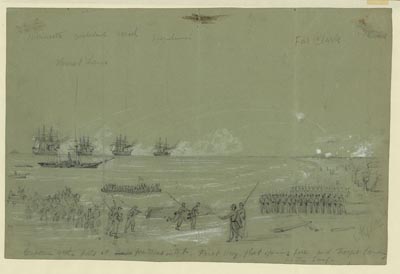Daniel Bright
Featured Character – Divided Allegiances

Capture
of the Forts at Cape Hatteras Inlet-First Day, Fleet Opening Fire and
Troops Landing in the Surf
Courtesy of the U.S. Library of Congress
A yeoman farmer and slave-owner,
Daniel Bright enlisted in
the 17th North Carolina Infantry as a
private. Captured
following the Battle of Hatteras Island, Bright spent time in two Union
prison
camps before his parole in December 1861. Bright rejoined the
Confederacy
as a member of the 32nd North Carolina Infantry,
but mustered out of
the regiment at the expiration of his enlistment in early
1862. Upon his
return to Pasquotank
County,
Bright joined a
local band of Confederate guerrillas. During Union General Edward Wild’s Raid, Union
soldiers
captured Bright and burned his house. At a hearing before
General Edward
A. Wild, Bright claimed to belong to the 62nd
Georgia Cavalry, a
regular Confederate force assigned to the Albemarle
region. Unfortunately for Bright, he failed to produce any
documents,
such as furlough passes or enlistment papers, verifying his
status. At
his court-martial before General Wild, local Unionists testified to
Bright’s
involvement with the local partisans. Convinced of Bright’s
guilt, Wild
ordered his execution. The next day, December 13, 1863, just
north of Elizabeth
City
at Hinton’s Crossing, Union troops
devised a primitive gallows within the unfinished post
office. Hanging
the rope from a wooden joist, Wild ordered the condemned man to stand
on a
empty cider barrel. At a prearranged signal, Federal troops
pushed the
barrel from under Bright’s feet. Since the fall failed to
break his neck,
it took almost twenty minutes for Bright to slowly strangle to
death. As
the Union column headed up the road to their base in Norfolk,
they left a note pinned to his back:
“This guerrilla hanged by order of Brigadier-General Wild.
Daniel Bright,
of Pasquotank
County.”
Wild’s actions sent a
message of fear to Confederate forces. Greeted with significant
outrage by both
Union and Southern sympathizers, Bright’s death played a leading role
in the
ultimate decision by North Carolina Governor Zebulon Vance to pull
Confederate
guerrillas out of the Albemarle Region.
